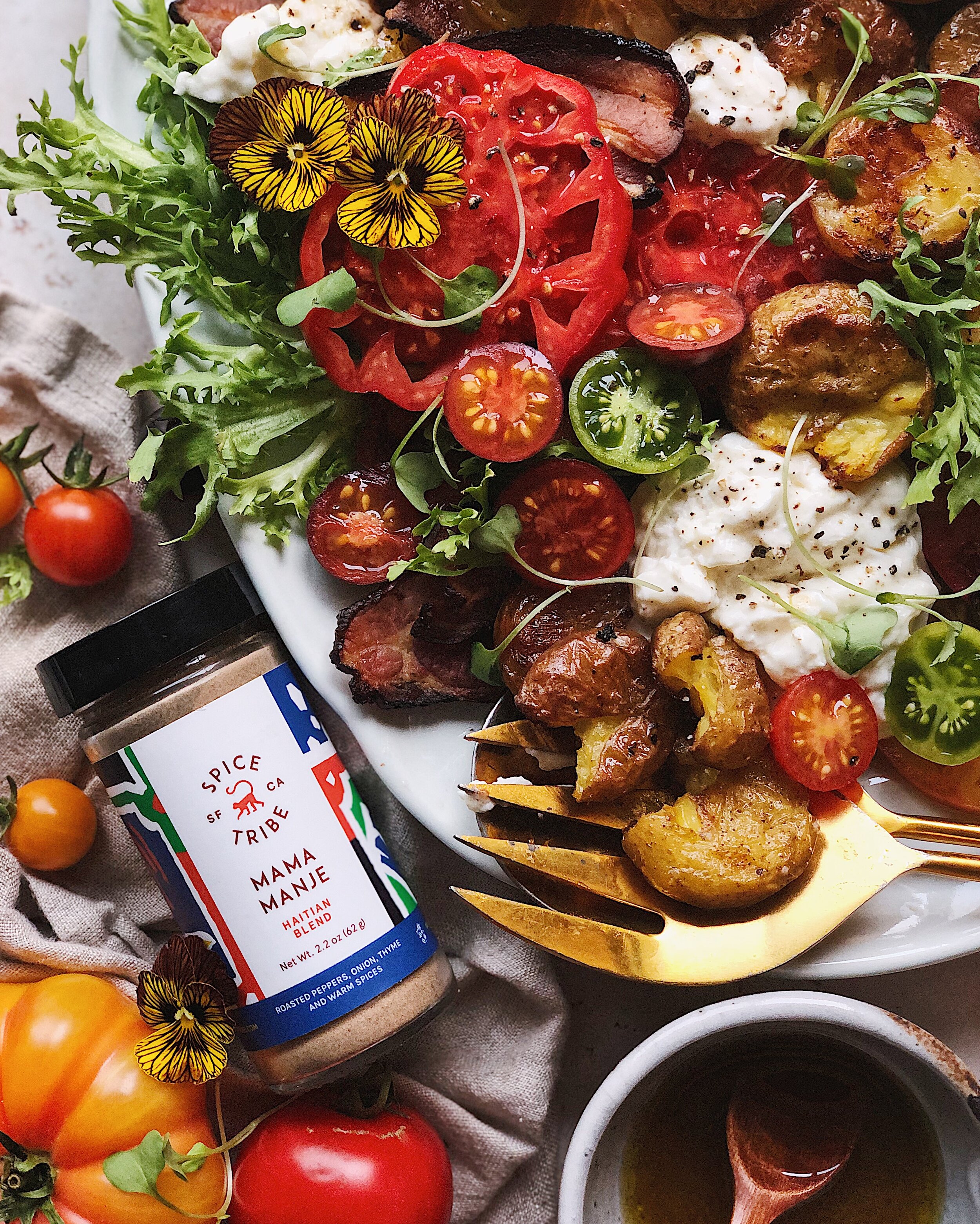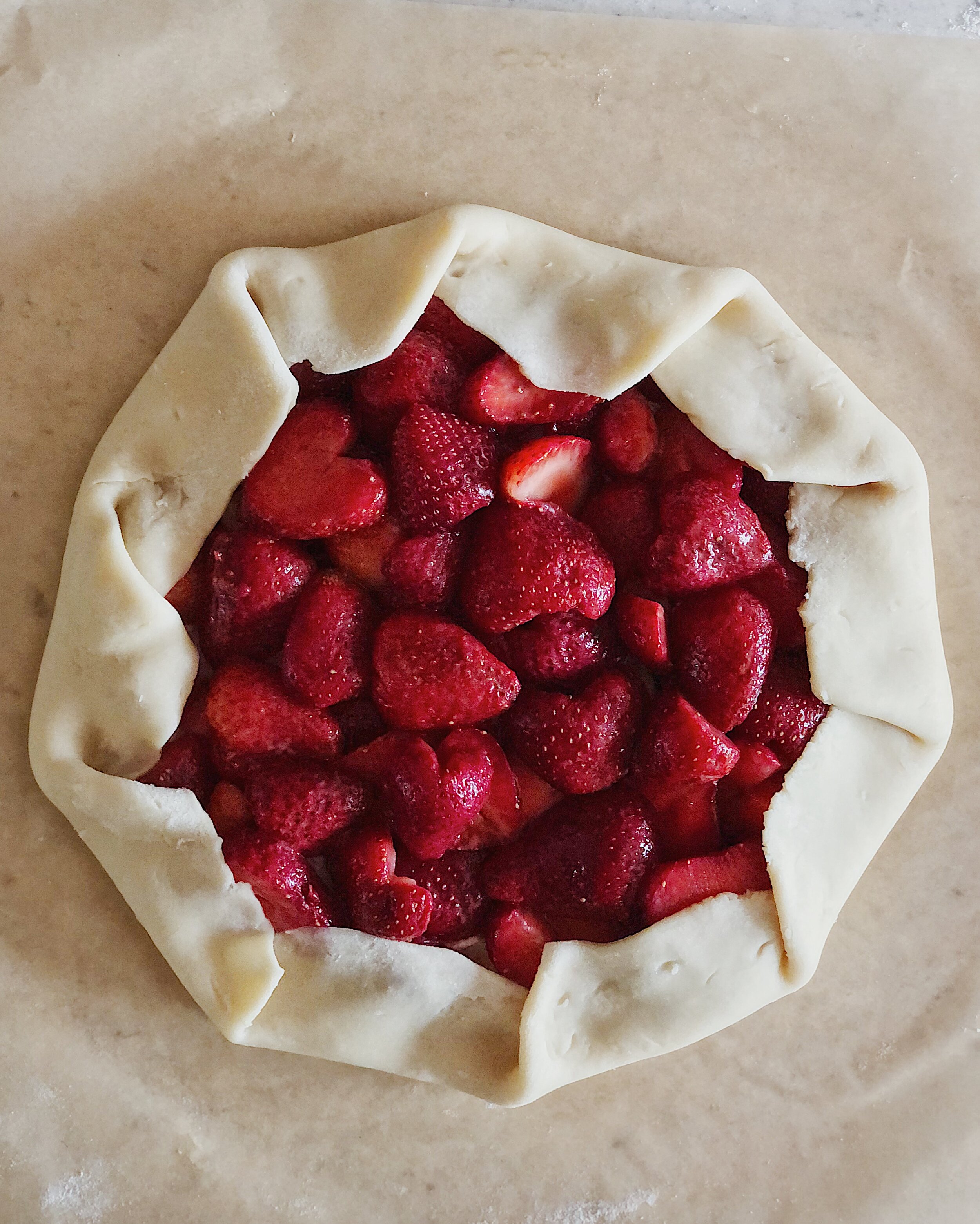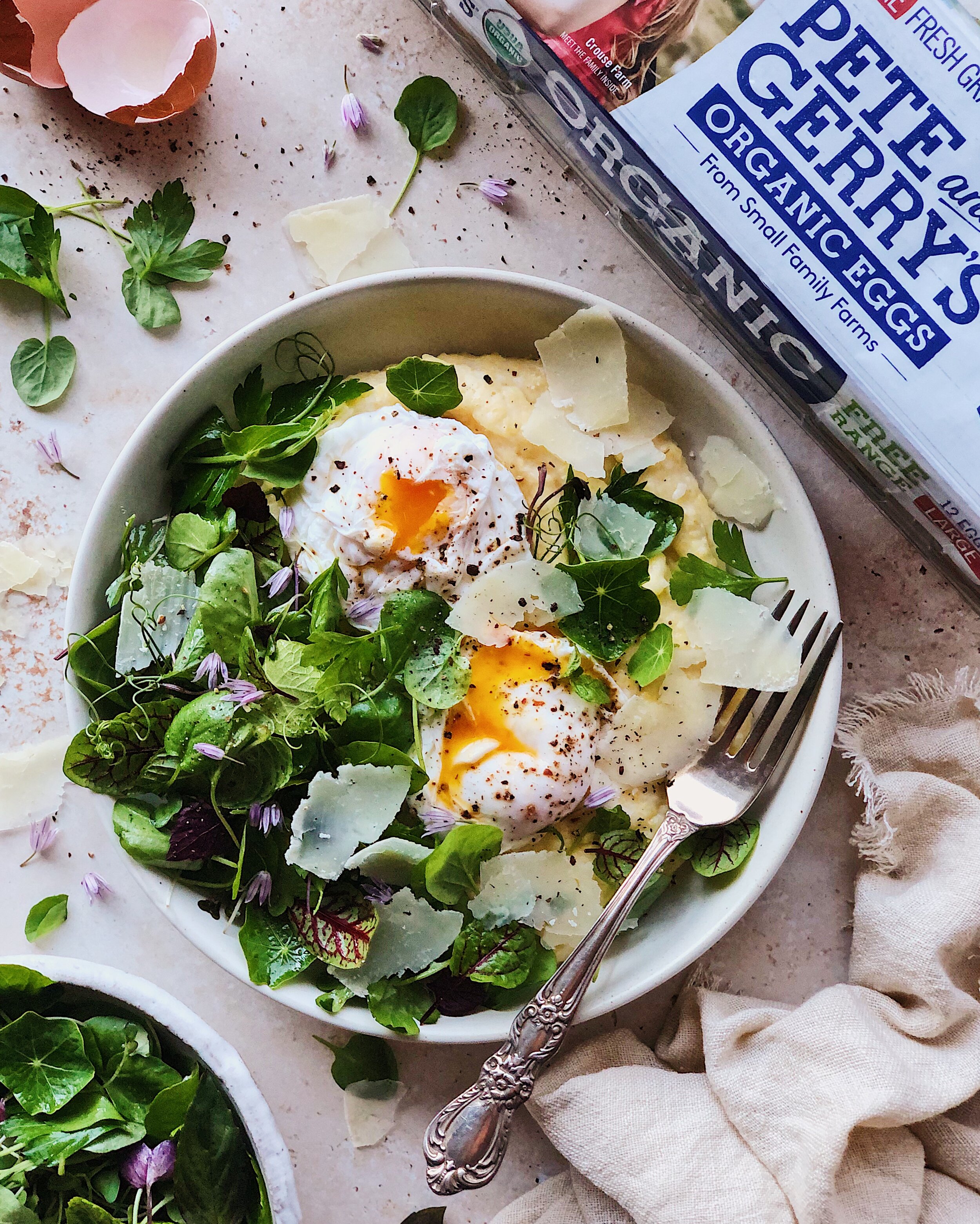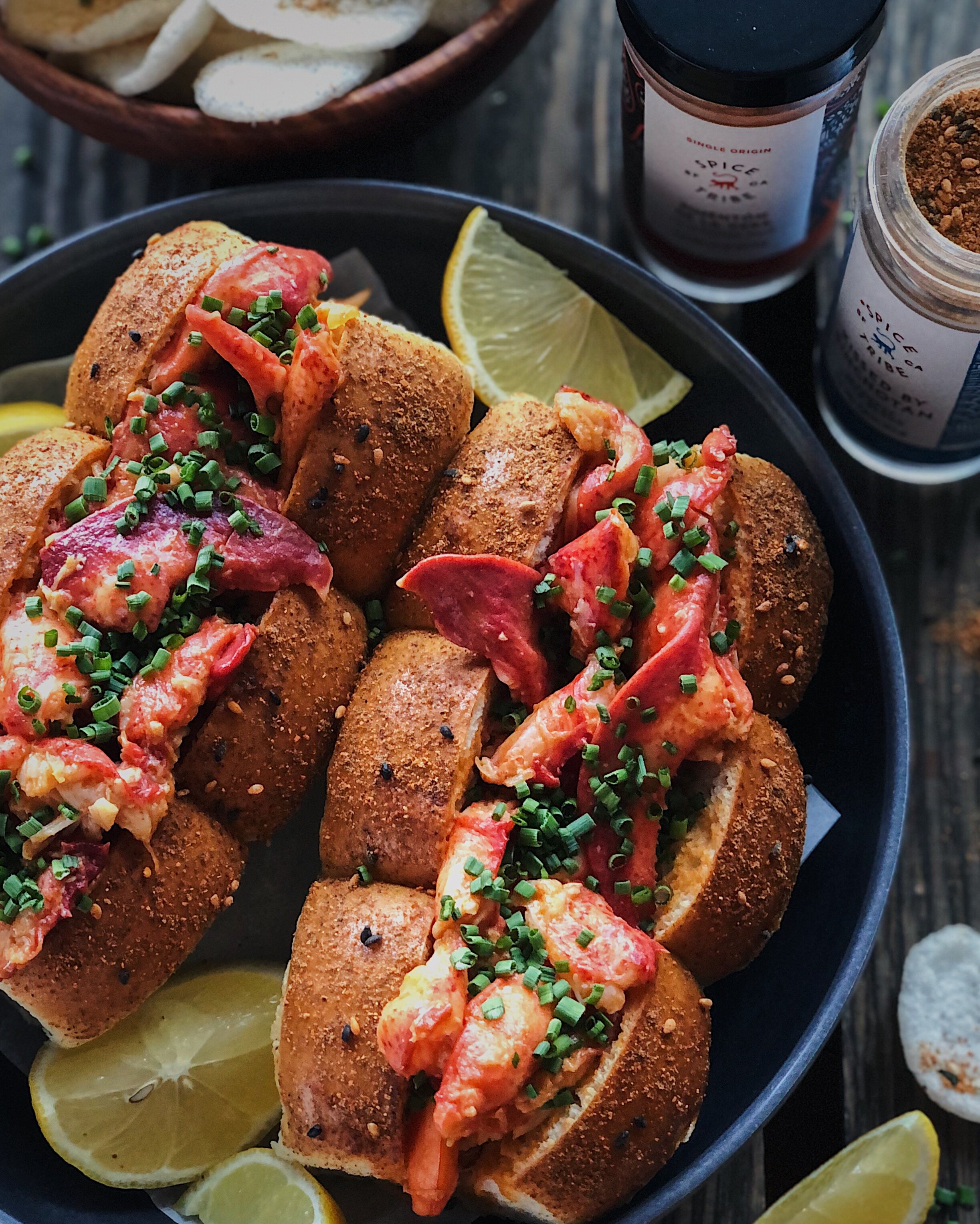Recipe: BLT Salad with Crispy Smashed Potatoes
/BLT sandwiches seem to be having a moment right now—I recently saw Kenji post one on Instagram and Munchies did a short video on Youtube. I mean, it makes sense for everyone to be wanting a BLT at this time because it is after all peak tomato season, a.k.a. THE MOST WONDERFUL TIME OF THE YEAR! But for me, a little BLT sandwich is still not enough tomato. My obsession with the produce bounty of late summer is so strong, that it can only be satiated with an entire platter of tomatoes! And that, dear reader, is where the BLT Salad comes in.
Imagine a scenario where, instead of biting into your favorite ingredients of a BLT and having those precious sweet peak-season tomato juices running down your hands, a civilized fork allows you to assemble the perfect bite without the sticky mess. That is the beauty of the BLT Salad. I thought of doing this as a panzanella with nicely seasoned croutons to continue to honor the sandwich origins of this flavor combo, but I realized I was too proud of my smashed potatoes recipe to not want to share it with you all. And there is something about the creamy fluffiness of those potatoes that goes so well with the juicy tomatoes and the salty bacon. Hence, I now present to you my BLT salad with crispy smashed potatoes and, of course, burrata.
These crispy smashed potatoes are so good as part of a breakfast platter, as a side dish with whipped feta and herbs, and—obviously—as a way to bring heartiness to a salad. I use Spice Tribe’s Mama Manje Haitian-inspired seasoning blend whenever I make them, and these seasonings blooming in the oven as the potatoes roast makes my whole house smell so, so good. The blend was inspired by Spice Tribe founder Trent’s visit to Haiti with the non-profit Every Mother Counts, and is meant to capture a combination of the ingredients in epis, a foundational seasoning blend for Haitian cuisine, and the tea that is commonly drank by Haitians. To me, the combination of green bell pepper, onion, thyme, cinnamon, garlic, ginger, habanero, and star anise works so well as an all-purpose seasoning, and in addition to this smashed potatoes recipe, I have been using it whenever I want to imbue a dish with a complex blend of flavors and not have to think too much about it.
You can read more on the story behind Spice Tribe’s Mama Manje Haitian blend from Trent here. While working on this recipe, the recent devastating earthquake in Haiti was on my mind, as well as how much of a privilege it is for me to do things like recipe testing for my job. If I was going to be earning income from a product inspired by a humanitarian visit to Haiti, it felt important to me to pay it forward. I decided to donate 5% or my rate from this sponsored recipe to World Central Kitchen and Spice Tribe has kindly agreed to match my donation too. I chose this charity because it was founded by José Andrés—a chef that I respect and admire—in response to sending aid for the 2010 earthquake in Haiti, but they have since expanded their relief efforts globally. They are currently working to provide food to those experiencing homelessness as a result of Hurricane Ida, facilitate hot meals for refugee families fleeing Afghanistan, and mobilizing their already-well-established teams in Haiti to provide assistance in response to the recent earthquake. You can join me in donating to these efforts and read more about World Central Kitchen here.
Going back to the recipe, here is a bit about what you’ll need to bring it all together:
bacon (the B): I used a center cut, thick cut bacon that was nice and meaty by bacon standards. The bacon gets crisped in the oven on the same tray as the smashed potatoes, so that rendered bacon fat is surely not going to waste as it spreads across the pan. I kept the bacon in big chunks because this is a big chunky salad! No gum stabbing bacon bits here.
frisée “lettuce” (the L): I took some creative liberties here in representing the L in BLT by using frisée, which is technically not a lettuce but a type of chicory. Frisée (also known as curly endive) and other chicories work well in this salad because they are sturdy enough to not get sogged down by the juicy tomatoes or the warmth of the roasted smashed potatoes, and their slight bitterness is a nice contrast to the salty fatty bacon. But you could also use your choice of baby lettuce leaves.
tomatoes (the T): I used a combination of heirloom tomatoes from the store and cherry tomatoes I grew myself in the backyard. Try to use the most flavorful tomatoes you can get your hands on because the whole point of the dish is to celebrate their gorgeous natural flavor. In the recipe, I suggest drizzling a little dressing over the salad platter and then adding more to taste, because you may or may not need more dressing depending on how flavorful your tomatoes are.
mini potatoes: Instead of croutons, I opted to make crispy smashed potatoes to bring some heft and heartiness to this late summertime salad. I have found that creamer potatoes with thin skins and a waxy consistency work best for this. First I boil the little potatoes until they are almost breaking apart, then I gently smash them down on a baking pan with a fork to expose some of the soft, fluffy interior and create lots of craggy edges to crisp, then I roast them until the house smells amazing and those edges turn golden. Though there’s a multi-step process to making these, it’s well worth it.
burrata: I couldn’t resist bringing a lusciously creamy element to this salad, much like how a BLT would not be complete without mayo. I opted for burrata because I am obsessed with how this softest of cheeses pairs with the tomatoes. But if you can’t find burrata, some fresh mozzarella would work great here too.
How to Make a BLT Salad with Crispy Smashed Potatoes
For the Smashed Potatoes
1 pound mini creamer potatoes
1 1/4 tsp kosher salt, divided
2 tbsp extra virgin olive oil, divided
1/2 tsp Spice Tribe Mama Manje blend
4–6 strips center cut thick bacon
For the Dressing
2 tbsp fresh orange juice
4 tsp white wine vinegar
1 tbsp honey
1/4 tsp Spice Tribe Mama Manje blend
1/4 tsp kosher salt
2 tbsp extra virgin olive oil
For the Salad
3–4 heirloom tomatoes, sliced
1 cup frisée or baby lettuce leaves
4 oz burrata or fresh mozzarella
cherry tomatoes (optional)
microgreens (optional)
kosher salt and pepper, to taste
Procedure
In a medium pot, combine potatoes with 6 cups of water, or enough to completely cover the potatoes in 2 inches of water. Bring to a boil and add 1 teaspoon of salt. Continue boiling potatoes until very soft and a fork pokes through with no resistance, about 20–25 minutes.
In the meantime, preheat oven to 450°F and make the dressing. Combine all dressing ingredients except olive oil in a bowl and whisk together until the honey dissolves. (Microwave for 10 seconds if needed to soften the honey.) Then, slowly whisk in the olive oil. Set dressing aside.
Drain boiled potatoes well and allow to cool slightly. Add to a large mixing bowl along with 1 tablespoon olive oil, 1/4 teaspoon salt, and Spice Tribe Mama Manje blend. Toss until potatoes are evenly coated, then dump everything onto a large baking sheet.
Move potatoes to the sides, then press each one gently with a fork until it cracks open and flattens sightly. Drizzle another 1 tablespoon olive oil over smashed potatoes. Place strips of bacon in the middle of the same baking sheet, in a single layer.
Place baking sheet on the middle rack of the oven. Bake for about 8 minutes, flip the bacon, then continue baking until the bacon is crisp, an additional 7–12 minutes (for 15–20 minutes total). Transfer bacon onto a plate to cool slightly (bacon will become a bit more crispy while cooling). Continue baking potatoes until the fluffy edges begin to turn golden brown, about 5–7 minutes more.
Break up bacon into bite-sized pieces. Arrange frisee or lettuce leaves, tomato slices, bacon, and crispy smashed potatoes on a serving platter as desired. Season tomatoes with salt and pepper to taste. Top with torn up pieces of burrata or mozzarella, and additional cherry tomatoes and microgreens (if using). Lightly drizzle some dressing over everything and serve the rest of the dressing on the side.
Thank you so much to Spice Tribe for sponsoring this recipe! Check them out on Instagram here or visit their website to purchase high quality spices and unique small-batch spice blends.










































































